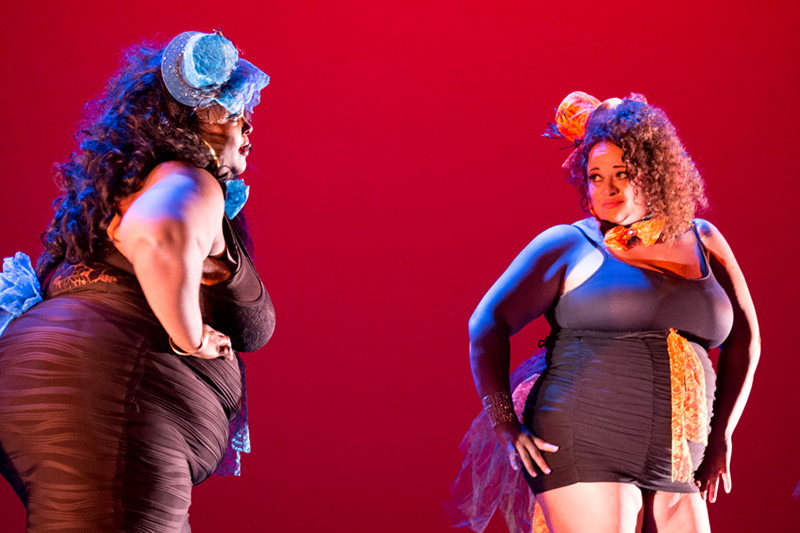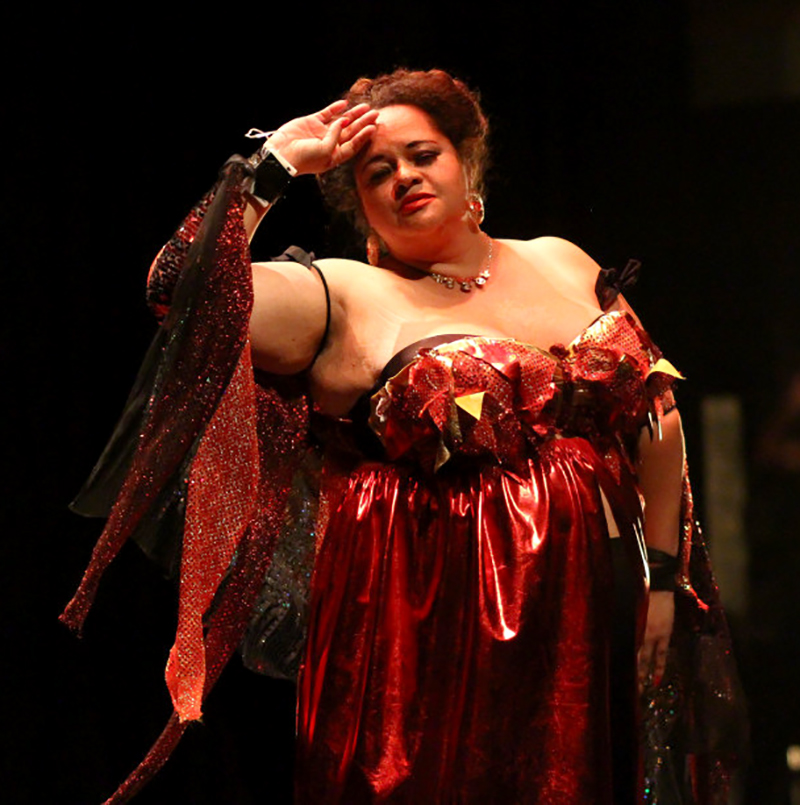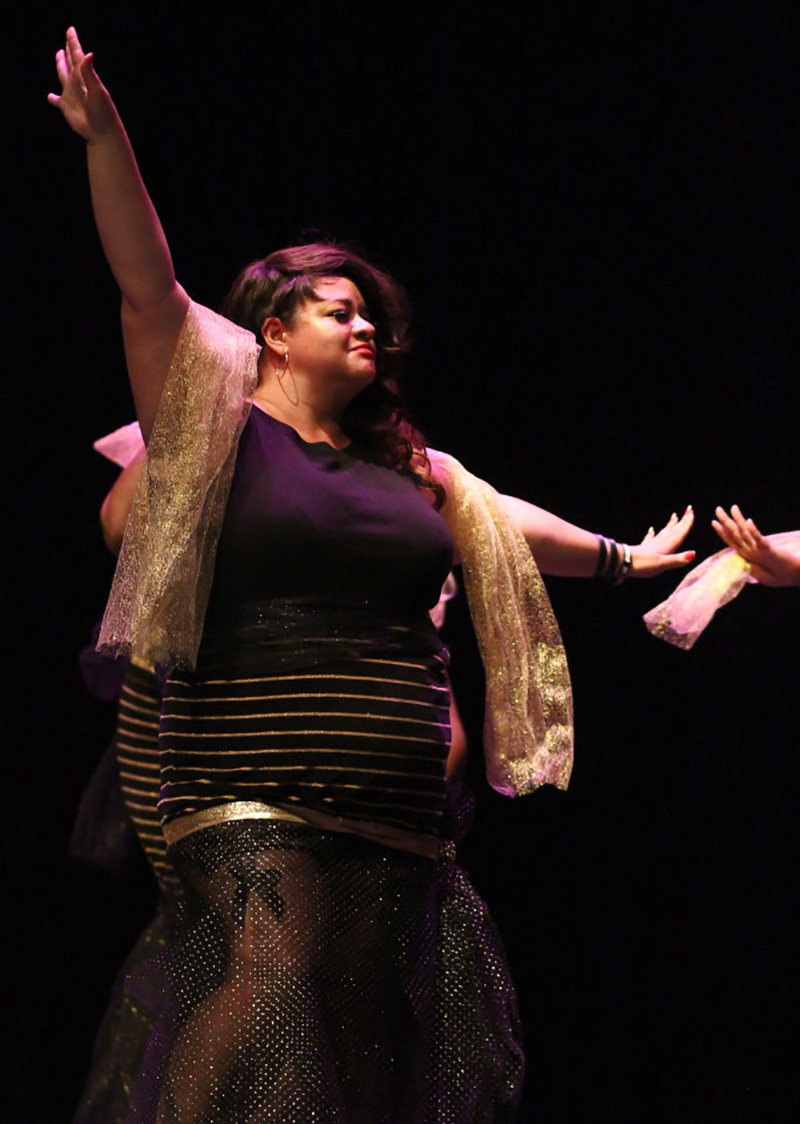Entwining Fat Dance and Activism
An Interview with Tigress Osborn
BY EMMALY WIEDERHOLT
Tigress Osborn is a dancer and fat activist currently based in Phoenix, AZ. She has performed as a guest with Big Moves, a fat dance company and advocacy organization based in the Bay Area, for almost a decade. Here, Tigress shares how her dance life is entwined with her fat activism, and how fat visibility is a key component driving her work.

Saucye West and Tigress Osborne, photo by Lisa J. Ellis
~~
Can you tell me about your dance history and what shaped who you are as a dancer today?
The first time I danced publicly as an adult was as a guest performer at a concert for Big Moves, an Oakland based plus size dance troupe. I am not formally trained as a dancer. After years of performing in dance shows and festivals and even once on television, I still think of myself as someone who likes costumes and who is willing to dance in front of people. My training has been on-the-job, choreographing on myself and working with more experienced choreographers to put together solo or group performances, and primarily doing that through fat positive troupes like Big Moves or fat inclusive burlesque. Fat visibility has been my focus, along with showing off fat dancers in fancy costumes.
I originally heard about Big Moves when I was living in Oakland through a Yahoo group that was sharing plus size events. I went to see a concert of theirs in San Francisco. The emcee of that event was Marilyn Wann, a prominent fat activist who at the time was based in the Bay Area. She is known for Yay! Scales, which are deconstructed bathroom scales that give you a compliment when you step on them instead of a number. My friend won the door prize, so I took a picture of my friend and Marilyn and got Marilyn’s email address. I started to stay in touch with her as well as started following Big Moves and seeing what they were doing. This was in the early days of social media.
Not long after, I opened a plus size night club event. It was a space for fat people to go dancing on Friday nights. Somehow, through my work with my night club, Big Moves invited me to emcee one of their shows. So the first time I was onstage with Big Moves, I was their emcee. Some of the girls who modeled for my nightclub got this idea that we should do a dance performance at the club. I was hesitant because what happens at a nightclub is it’s hard to get people off the dance floor for a performance, and then once the performance is over, it’s hard to get them back. So we performed together at Big Moves instead.
You’re also involved in a lot of fat activism. Can you share what your involvement is with Phx Fat Force and with the National Association to Advance Fat Acceptance (NAAFA)?
I’m one of the co-founders of Fat Force here in Phoenix. My co-founder is Nicholet Deschine Parkhurst, who goes by Redstreak Girl on Instagram. She is a plus size fashion blogger. When I was moving to the Phoenix area, I reached out to her to get coffee. She wanted to put together a clothing swap. So we started Phx Fat Force by creating fat positive events in Phoenix, but it was right before the pandemic started. As a result, we’ve mostly been a small online presence and have been doing support work for other organizations like signing letters about fat positive media requests and things like that. We expect to get back to doing events next year.
My deepest involvement in fat community these days is through NAAFA. I became the board chair in 2021, and I’ve been on the board for a few years. NAAFA is the world’s oldest fat rights organization. It was founded in 1969. As the grand-elder of formally organized fat groups, NAAFA has been a lot of things to a lot of people, pro and con. This is an exciting time for NAAFA because we’ve committed to an intersectional approach in a way that the organization never had before, which means we’re reaching a lot of different people, and a lot of different people are reaching out to us.
How has your involvement in advocacy informed your dance practice, and vice versa?
Being onstage as a fat dancer requires a certain amount of unapologetic attitude about your body. You are aware that at that performance and in photos or videos later, your body and its perceived flaws could become more of a focus than your dancing. Without any politics behind that, it would be easy to say that I would have more opportunities in dance if I just lost weight. It would be easy to give in to diet culture as a way to be invited to dance. But for me, dance was always about fat visibility. The creative aspect of choreography and costuming was always more interesting to me than the physical aspect, which is complicated now because my body is having mobility issues. But being part of an inclusive dance community is what made it possible for me to even think of myself as a dancer. Instead of thinking, “I’m having mobility issues so I can’t dance anymore,” I think of it as, “I’m having mobility issues; how do I dance now?” If I wasn’t involved in the activist movement and had those constant conversations about accommodation, visibility, and an unapologetic attitude about living in the body I have, it would have been easier to stop dancing or maybe not even start in the first place.
When I was a kid, I never saw myself as a dancer. My older cousins made fun of me because they thought I was a terrible dancer. I had this proud moment as a sixth grader when I was on student council and we were planning a dance, and the teachers didn’t know why we were planning a dance because the students never danced, but I got people on the dance floor by dancing. It’s one of my favorite kid memories. And yet as I grew older and more self-conscious, it was so easy to get worried about people looking at me and making fun of me. It’s so easy for that to become ingrained in this culture.
I saw Big Moves before I ever danced publicly. The existence of this whole generation of fat dancers before me that I got to know through fat activism made it possible for me to envision that for myself and made me want to be part of creating that vision for other people.
What are some ways people talk about fat dancers that carry problematic implications or assumptions?
The most problematic thing is that people think we don’t dance, that fat dancers don’t exist. Or they think fat dancers can’t do the same things as other dancers. I can’t do some moves that other dancers can do, but I also know thin people who can’t do those moves. And there are thin people who can’t do some of the moves that I can do.
Then there’s the idea that if you’re fat and dancing, you’re doing it for weight loss, like we’re finally getting active. I’m not finally getting active. I’ve been dancing for 10 years and I haven’t lost any weight. And that’s not part of my goal.

Photo by Desmond Rodgers Photography
Are attitudes toward fat dancers getting better or worse from your perspective?
It’s really tough for fat dancers and other kinds of performers. I hear about that through my work with NAAFA as well as through folks I follow on social media. Part of how I know that it’s still really hard for fat dancers is it feels like there’s a quota for how many fat dancers there can be: If there’s one popular fat person dancing on Instagram or Dancing with the Stars, we can’t have another one until people get tired of them. We never say, “There have already been six thin groups, so we don’t need another one.”
I’m not as deeply immersed in the dance world as others whose primary activity is dance. But I can see there’s more opportunity for fat dancers in some ways. Celebrities like Lizzo push the edges of what people think is possible for fat people in movement. There are more opportunities through Instagram and TikTok to see fat people dancing, and that’s inspiring other fat people to think they can dance too, but those public fat figures are highly trolled, and not about whether they are terrible dancers, but just about what their bodies look like.
What terminology are you comfortable with?
I prefer “fat.” I believe both personally and representing NAAFA that using “fat” destigmatizes the word. It’s just a matter of fact; I am fat. I love euphemisms because I’m a creative writer and I think they can be fun. When people call themselves “fluffy” and things like that, it doesn’t offend me. But I like them in addition to “fat,” not instead of “fat.” I think we need to not use words like “overweight” or “obese.” They are medically pathologized and create the impression that there is a particular weight that is the right weight and you can be over that, which I don’t believe. I love when trolls try to shut me down by saying I’m “glorifying obesity.” I’ll use “obesity” in that context because I am glorious.
The term “fat liberation” is inherently intersectional. The fat rights movement started with words like “fat acceptance” or “size acceptance.” “Acceptance” appears in NAAFA’s name. We don’t use “fat acceptance” as much these days, but we’re not changing it for historical reasons. “Fat liberation” has always been intersectional. That’s the best modern term for people who have made a political commitment to fat positivity.
What are some steps that professional and educational dance institutions can take to make their spaces more welcoming to fat dancers?
One thing they can do is use fat people in their marketing. If an institution says they’re body positive but only shows one kind of body and never shows fat, old, or visibly disabled people, how do I believe you and how do I know I won’t be the only one?
Also, the creativity piece of costuming has been a lot of fun for me as a dancer, but one of the things that is traumatizing for younger dancers or new dancers is trying to participate in a mainstream troupe and having to buy different costumes than everybody else. Thoughtfulness around costuming and accessories is really important.
As far as space, if an organization says they are body inclusive, but when I go to your registration area all the chairs have arms on them, fat people can’t sit in those chairs. Or for choreography that uses chairs, don’t use a chair that is weight rated to only 200 pounds. I can’t do that choreography because it puts me in danger. Things like that are practical considerations about the physicality of weight.
Do you have an upcoming project or focus you’d like to share more about? What’s next for you?
I am concentrating now on NAAFA and its growth, but I would love to get back to dancing more. I have a dream of taking a class with Jenzi Russell, who is an amazing choreographer here in the Phoenix area. I am looking forward to the next annual Big Moves show. I have performed as a guest dancer in their shows for nine years, and I’ve done a solo and group dance every year, so I’ve performed with them almost 20 times. Otherwise, I take a casual line dancing class for fun. I’m not sure what’s next beyond that.
Any other thoughts?
My most public performance was as a backup dancer on Sweden’s version of Got Talent. It’s me shaking my butt behind this rap act. One of the things that was interesting about that experience was that none of the comments on social media were about my body. If that video had gone up in the United States, it would have 1500 comments along the lines of “how dare this fat girl.” Part of the reason I performed on the show was because my friend who was the rapper couldn’t find a dancer in Sweden who would talk about being plus size. He found one dancer who he started working with, and he referred to her as curvy and she quit because she was offended. So he thought he needed some of his American friends with their bold selves. That’s how I ended up doing the video.
One of the things I am most proud to have participated in was the Fat Flash Mob. It was organized by Juicy D. Light who is the founder of Rubenesque Burlesque. Juicy and Alanna Kelly co-choreographed this flash mob in San Francisco. There’s a short documentary about it called Fat Mob, and it talks about coming up with the mob and how it all happened. I love those kinds of public displays because they are for anybody. You didn’t have to be a trained dancer to learn the simple choreography. And it didn’t even matter if you had the choreography perfect. What mattered was we all came together to do something joyful.
~~
To learn more, follow Tigress’ Instagram @iofthetigress.

Photo by Desmond Rodgers Photography
